Bowser Trains GLa 2-Bay Hopper
Published: 2023-12-01 - By: CNW400
Last updated on: 2023-12-01
Last updated on: 2023-12-01
visibility: Public - Headline
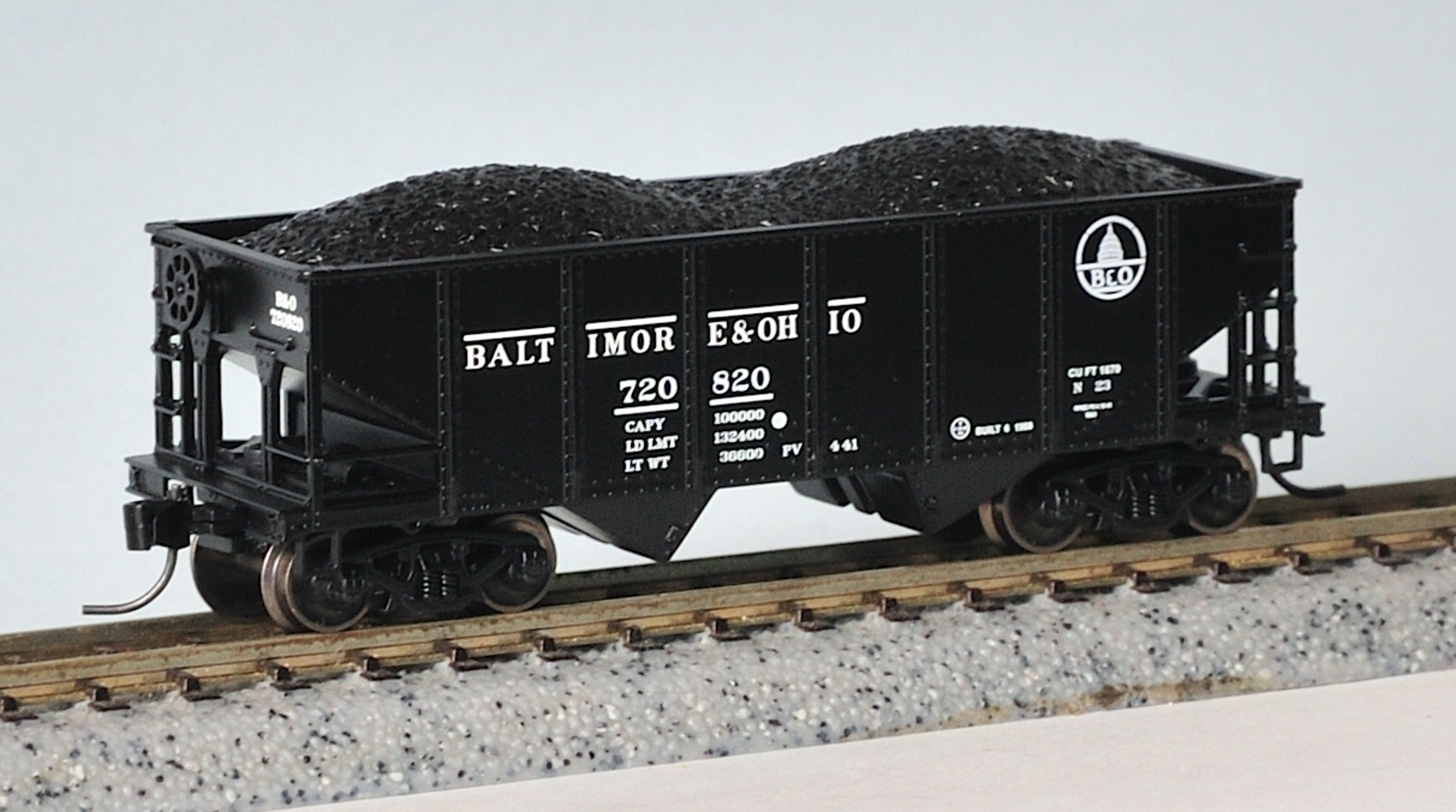
Introduction
The basic open hopper design is an empty box with wheels or a wagon with tall sides. The floor of the hopper railcar angles downward to outlet gates allowing the load to discharge freely. The heavily abused open hopper was one of the first all-steel constructed railcars – placed into service hauling coal and other aggregates (gravel, stone, etc.) from mines to industrial centers or shipping ports.
The Pennsylvania Railroad (PRR) developed their first drop-bottom discharge door hopper with the wooden GG-Class freight car in 1895. With an original load capacity of 40-tons -- this 30-foot long, two-bay rail car helped to differentiate hoppers from gondolas with sloped ends and gravity controlled unloading gates. The last GG-Class wood hopper was built in 1899 – soon after the Pennsylvania Railroad turned its attention to the all-steel car being offered by the Pressed Steel Car Company.
In 1890, Charles Schoen received the patent for an all-steel car and created the Schoen Pressed Steel Company in 1895. Schoen Pressed Steel began to manufacture the steel GL hopper cars in 1898 – then merged with the Fox Solid Pressed Steel Company in 1899 to form the Pressed Steel Car Company.
The Pressed Steel Car Company could not keep up with the great demand for their GL hopper cars. With many North American railroads experiencing a delay in receiving their freight car orders, the Pennsylvania Railroad took it upon themselves to produce their own hopper cars based on the Pressed Steel design. With a few modifications to perceived structural flaws – the Pennsylvania Railroad GLa open hopper cars were released in 1904. The PRR GLa hoppers were redesigned to distribute load weight upon the steel sides and frame posts and the fishbelly side sills were removed. These alterations lessened the light weight of the car and increased the load capacity for these 50-ton hoppers.
The Pennsy GLa design quickly became the coal car standard with the Pennsylvania Railroad alone owning over 30,200 by 1917 – one of the most prevalent hoppers in North American rail history as the PRR also manufactured the GLa hopper for competing railways. Although the number of GLa hoppers on the Pennsylvania freight car roster diminished throughout the decades (15,000 in 1959 to 3,000 in 1965 to 200 in 1970) --- 77 GLa hoppers cars remained on the Penn Central register in 1973.
Simultaneously, the PRR was experiencing immense success with their 4-bay, 70-ton H21-Class coal hoppers – manufacturing approximately 36,000 units when their production ceased in 1923. The H21s were eventually replaced with the 3-bay, 70-ton H39-Class coal hoppers.
The early Pennsylvania hopper cars were painted ‘PRR Freight Car Color’ - more commonly referred to as either Tuscan Red or Tuscan Brown by the railfan community. The shades varied over the decades between an orange-red to brown-red color. Black was introduced to rolling stock in 1956.
Pennsylvania Railroad Lettering Schemes for New and Repainted Rolling Stock
- 1930 Circle Keystone Scheme
- 1954 Shadow Keystone Scheme
- 1956 Plain Keystone / Black Rolling Stock
- 1960 PRR Initials Scheme
First, the GLa hopper cars were initially assembled with K brake systems. In short, the K brake incorporates the air reservoir, brake cylinder, and control valve into one long device under the car. Later versions of the K brake did “split” the cylinder and reservoir & the valve into two different units. AB brakes were introduced in 1930 and quickly endorsed by the Association of American Railroads (AAR). AB brake systems separated the three components into individual units. All newly constructed rolling stock starting in 1932 were equipped with AB brakes as the AAR banned the use of K brake systems on interchange service. This ban was made official in 1953 as the date for eradication and upgrading was extended because of the Great Depression and World War II. Railcars with K brakes were still allowed to serve on interline tracks and yards – maintenance of way (MOW) and cabooses as an example. Secondly, early versions of the GLa had a vertical staff brake. Rebuilt cars were later fitted with power handbrake wheels.
In comparison, the Pennsylvania GLa hopper is terribly similar to the USRA Standard 50-ton twin hooper car with an inside length of 30’-5", interior width of 9’-6”, and height of 10’-0” with cubical contents hoovering around 1670 cubic feet.
Road Names and Pricing
Released in November 2022, Bowser Trains expanded their GLa 2-Bay Hopper collection with ten different paint schemes. Bowser has produced over 250 versions of this popular freight car. The road names included in the most recent series are:- Baltimore & Ohio (Black / Ex-Buffalo Rochester & Pittsburgh)
- Canadian National (Brown)
- Central Railroad of New Jersey (Fantasy Blue Coal)
- Interstate (Black)
- Lehigh Valley (Black / White Diamond Logo)
- New York Ontario & Western (Fantasy Blue Coal)
- Pennsylvania (Black / Plain Keystone)
- Pennsylvania (Tuscan Red / Circle Keystone)
- Pennsylvania (Tuscan Red / Shadow Keystone)
- Pennsylvania (Yellow / MOW Simplified Keystone)
My review includes observations of Bowser Trains (38201) - Baltimore & Ohio #720820.
The Model
The ready-to-run open hopper came packaged in a clear plastic jewel case with a slip-off lid and a one-piece plastic cradle to support the freight car. A sticky plastic film was wrapped around the model to protect the surface from blemishes. The storage case data panel is poorly designed with the stock number only visible when on the shelf – the freight car information (style, road name, and car number) is printed on the bottom of the insert.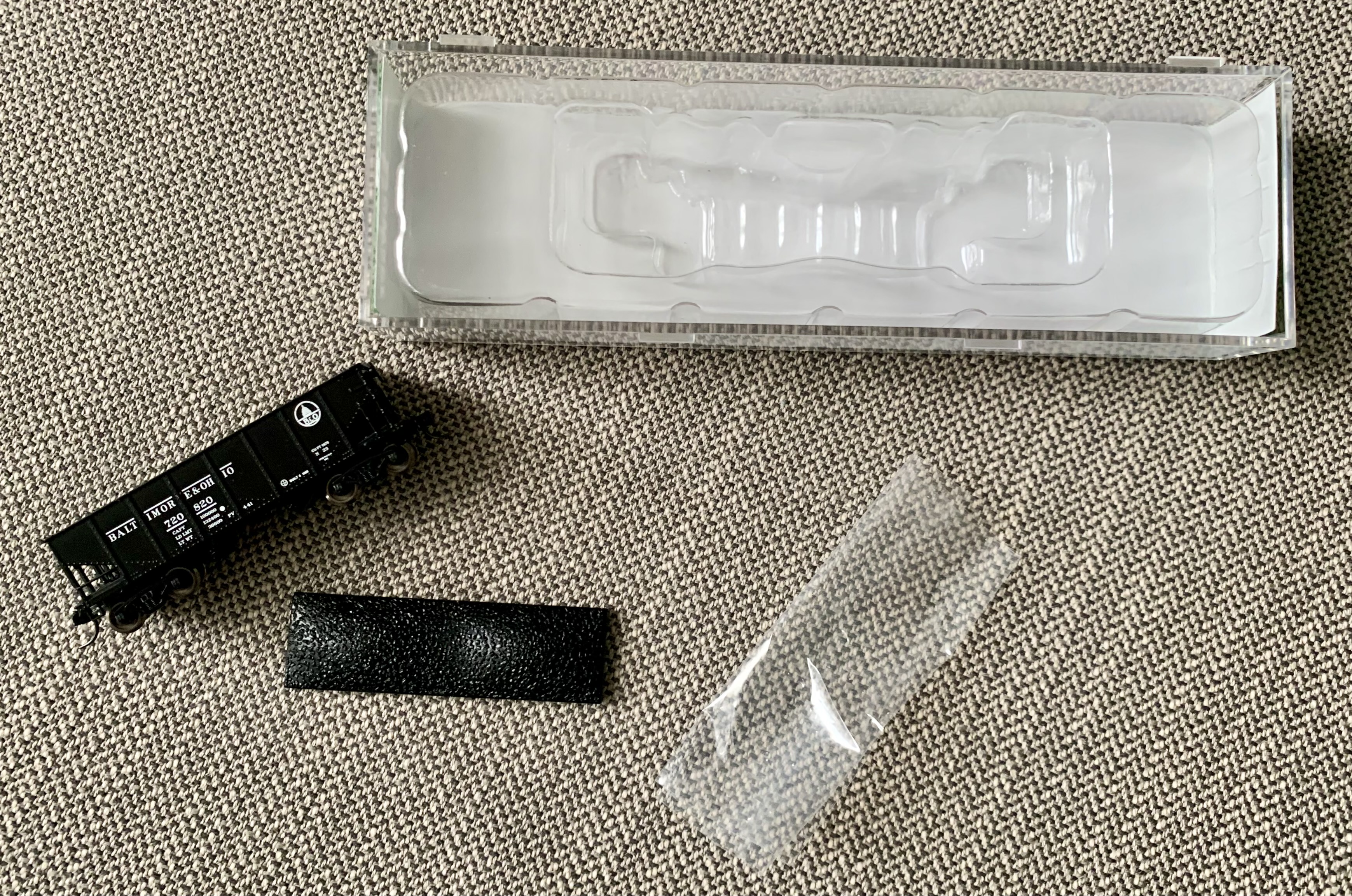
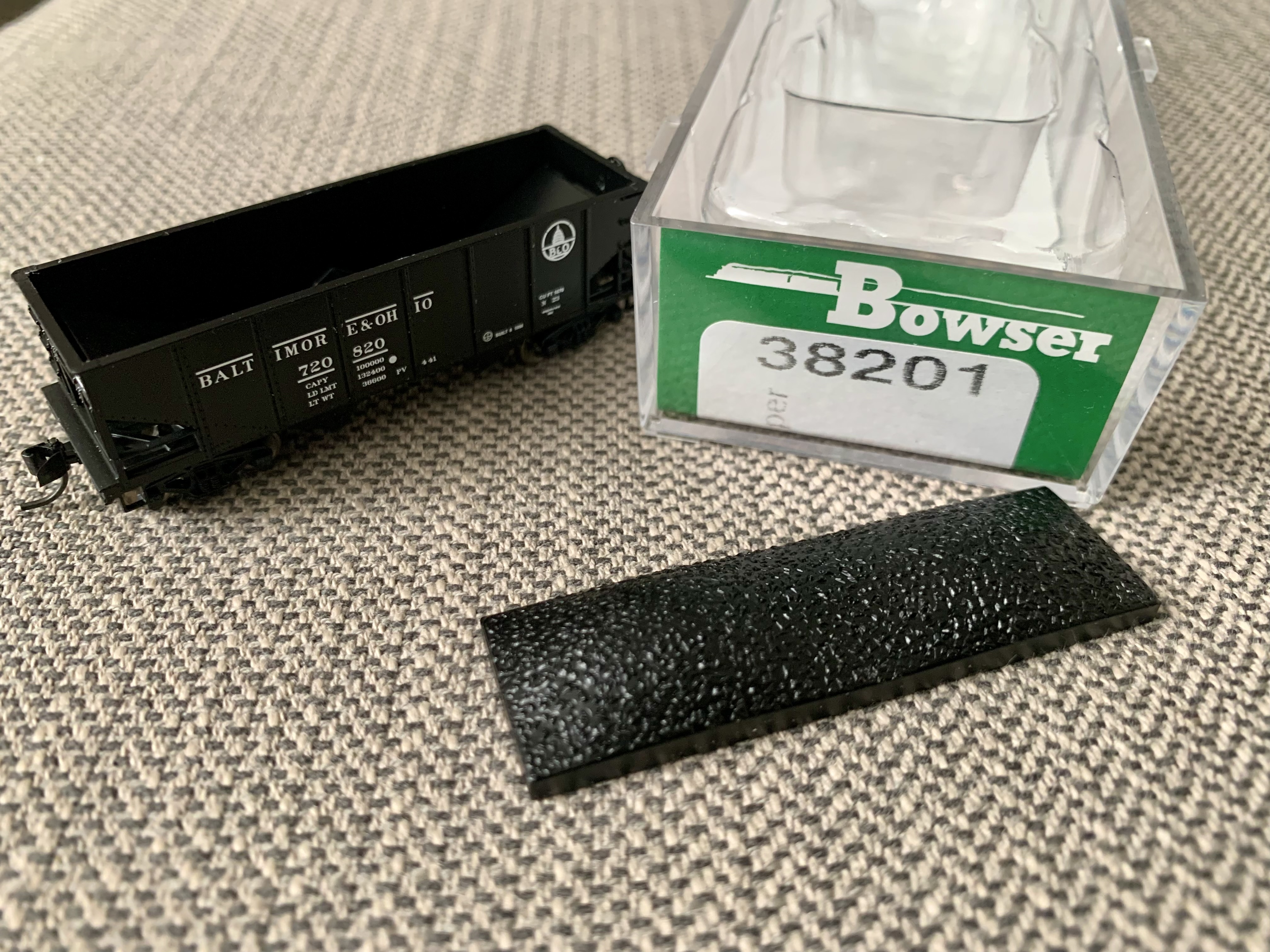
The Bowser model represents a two bay, 50-ton open hopper originally built for the Buffalo, Rochester, and Pittsburgh Railway (BR&P) in June 1908. The 1,670 cubic foot hopper was rebuilt at the Baltimore & Ohio’s Painesville facility in April 1941. The Bowser model shows these two dates above the bottom sill. The hopper is marked with the GLa subset designation of N-23 (Ribside/Ex-BR&P).
The black paint job is crisp and even along the entire model. The sides and ends of the model are injection molded plastic while the interior center bay sill is diecast metal. The white lettering is extremely sharp and clear, even when magnification is needed for the smaller printing. The placement, font, and size of printing is similar to prototype images for Baltimore & Ohio hoppers from that era with the twin solid white lines “boxing” the road name and car number. Also present is the iconic ‘Capitol Dome’ logo.
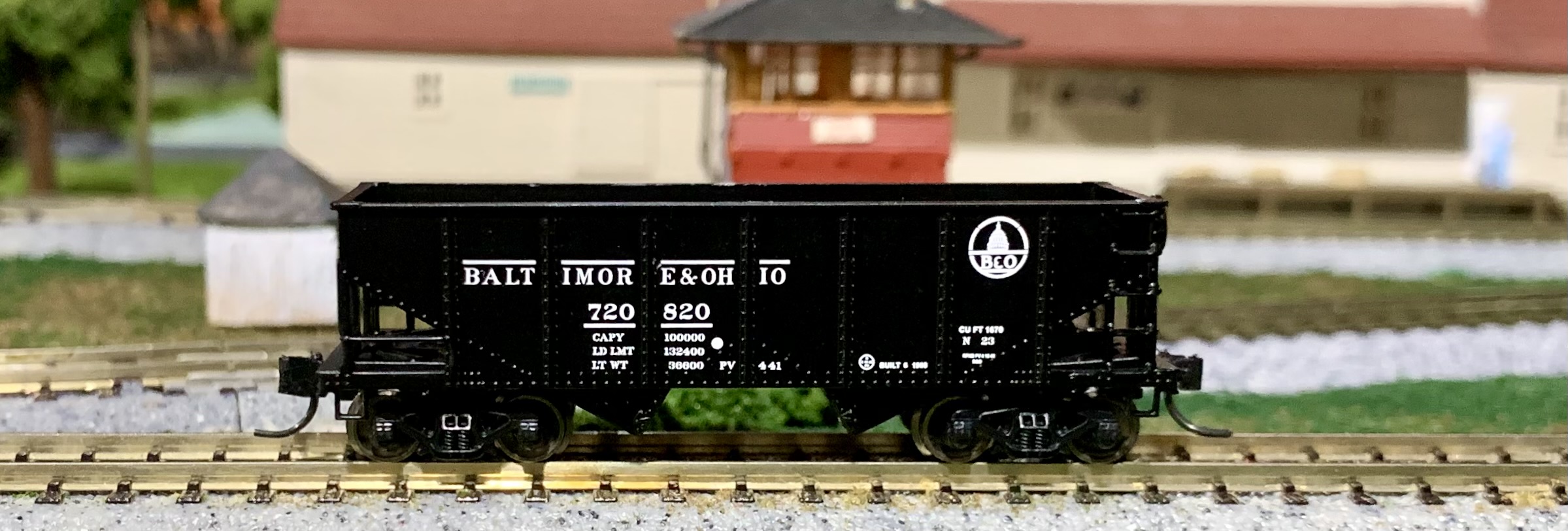
The B&O ‘Capitol Dome’ logo was created by industrial designer Otto Kuhler. In the 1930’s, Kuhler developed the company’s blue and gray color scheme - along with the dome logo representing the railroad’s lines into the District of Columbia. The B&O’s Capitol Limited passenger train ran from 1923 to 1971 between New York City and Chicago with stops in Washington D.C., Baltimore, and Pittsburgh. Amtrak inherited the line in 1971 with direct service between Washington D.C. and Chicago.
Each side of the model features the prototype correct riveted eight panel (six full and two half panels) section arrangement with seven exterior posts. The Bowser rivet detail is very sharp and in the same pattern as prototype photographs. The ‘sawtooth’ double discharge gates show molded opening latch detail. The side ladder has the correct five rung sequence with the Baltimore & Ohio unique ladder side rails NOT extending the entire distance to the top of the hopper on rebuilt cars (in contrast images of PRR GLa hooper cars have both side rails fully running the entire length of the ladder). Lasty, according to an article found posted by the B&O Railroad Historical Society – the solid white dot signifies that the railcar was approved to haul powered coal.
Both ends feature a full height ladder, molded grab irons, and twin support rails for the outer sloped discharge bays. A high mounted power handbrake with molded air tank and valve parts are visible on the B-end deck. The lettering is neat and in proper arrangement with the road marker and road number at the top right corner of each end.
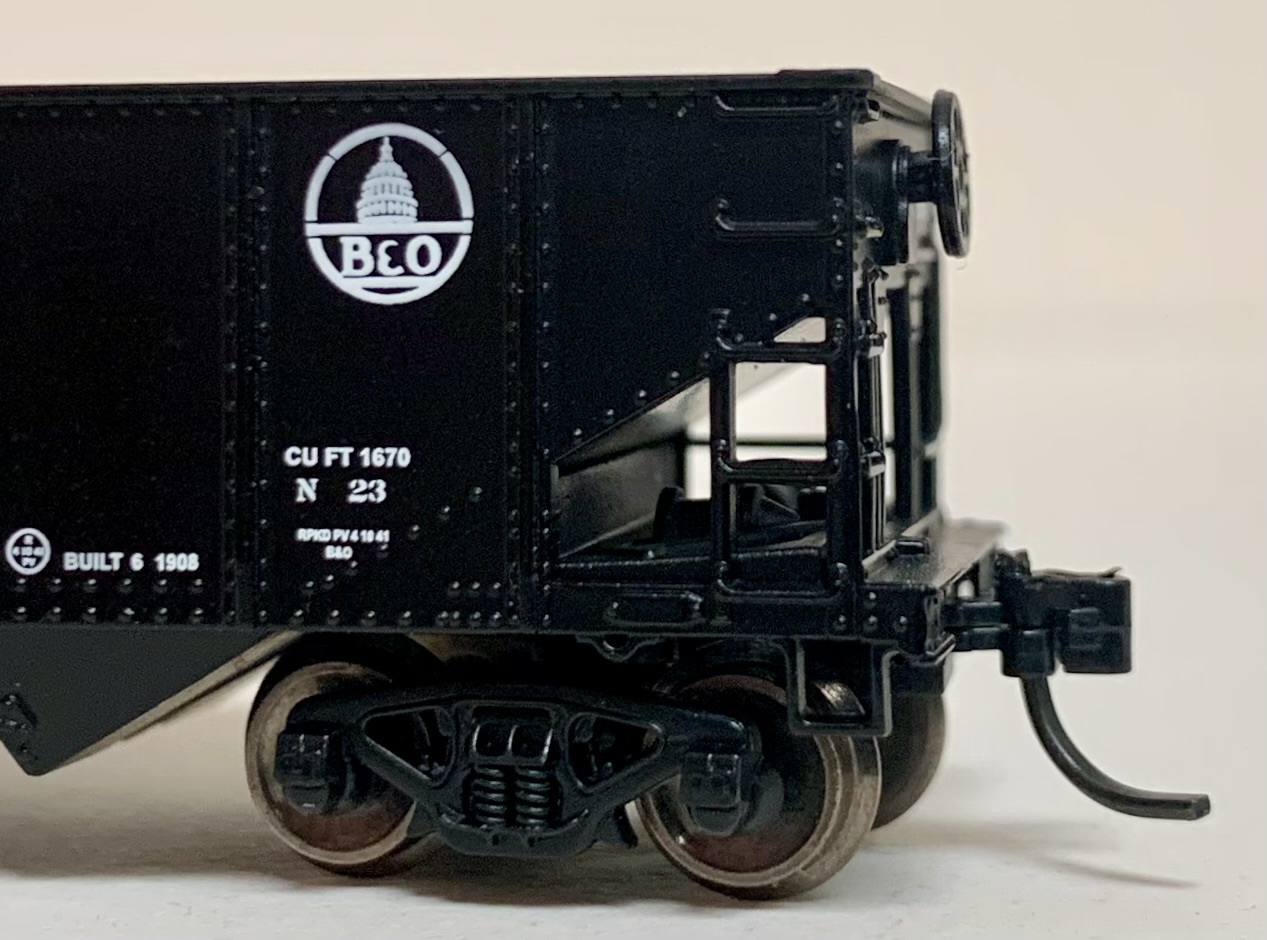
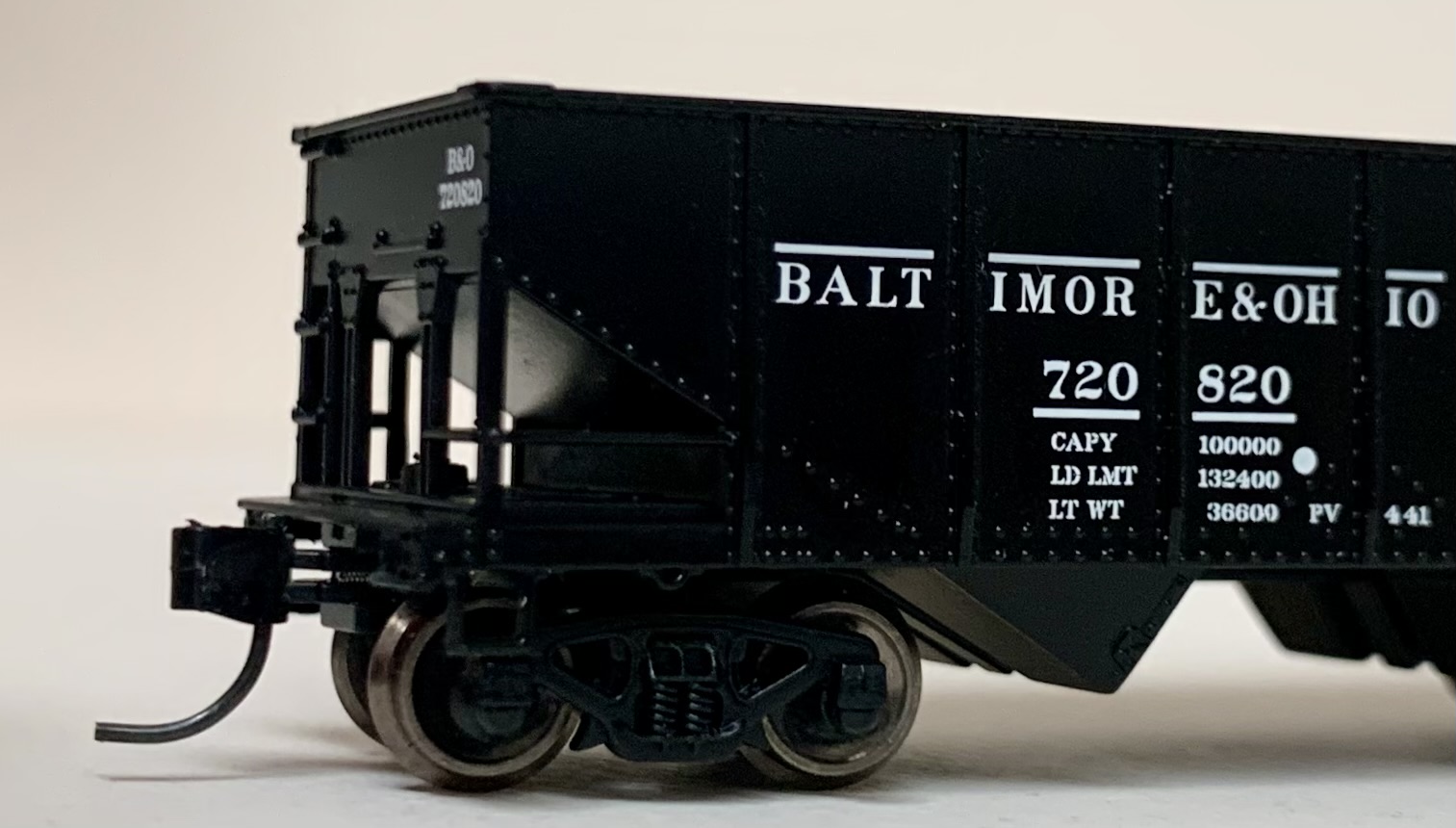
The inside of the two-bay hopper appears to have a diecast center sill with sloped sides directing the cargo towards the four outlet gates – each bay has two gates on either side of the hopper car. The interior offers no rivet or bracing details seen on other N scale two-bay hoppers...I understand this is not a big deal if you always carry a load on your rolling stock – but a few rivets would not hurt. The ordinary-looking coal hopper load is removable and extra weight can be hidden under this extremely thin, black plastic detail piece. A little sprinkle of authentic coal dust can make this a more attractive specimen.
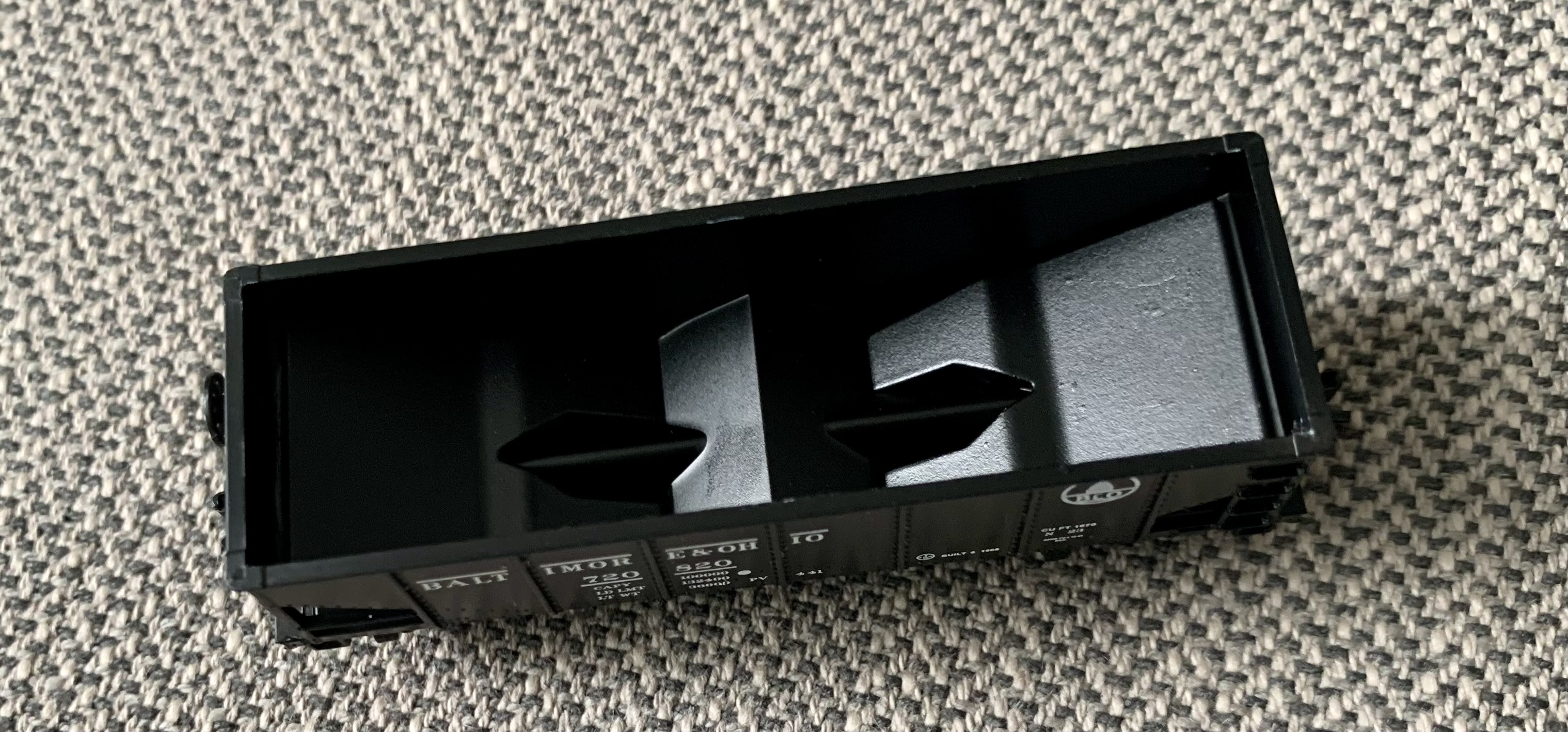
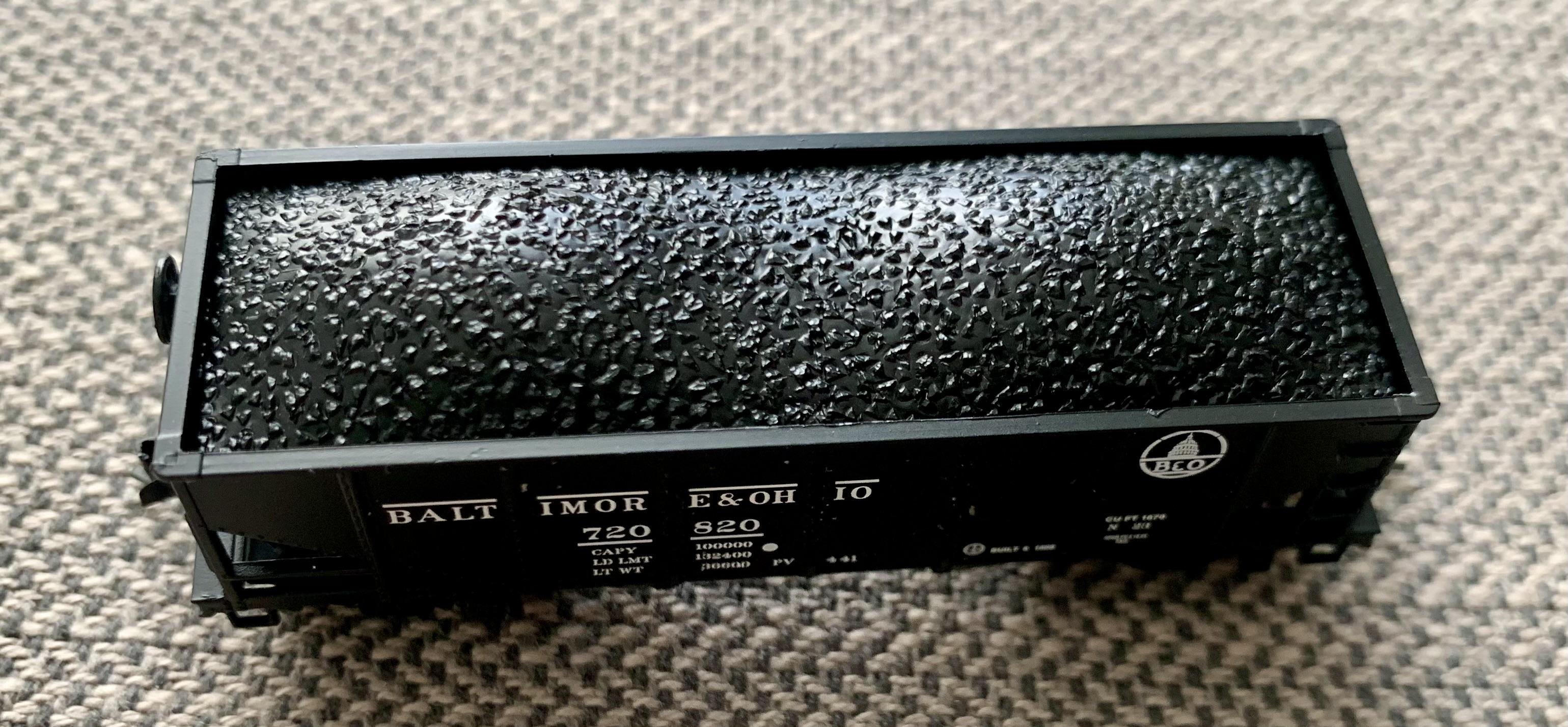
The bottom is also free of any rivet, gate, and braking gear detail except for molded framing on the four outlet bay doors. The Bowser GLa hopper rides upon prototype correct Pennsylvania Railroad 2D-F8 50-ton freight car trucks with blackened metal wheels. Both body-mounted knuckle couplers were affixed to the correct height, but I had difficulty keeping a connection with the Bowser car to any of my Bachmann Trains rolling stock fitted with EZ-Mate couplers.
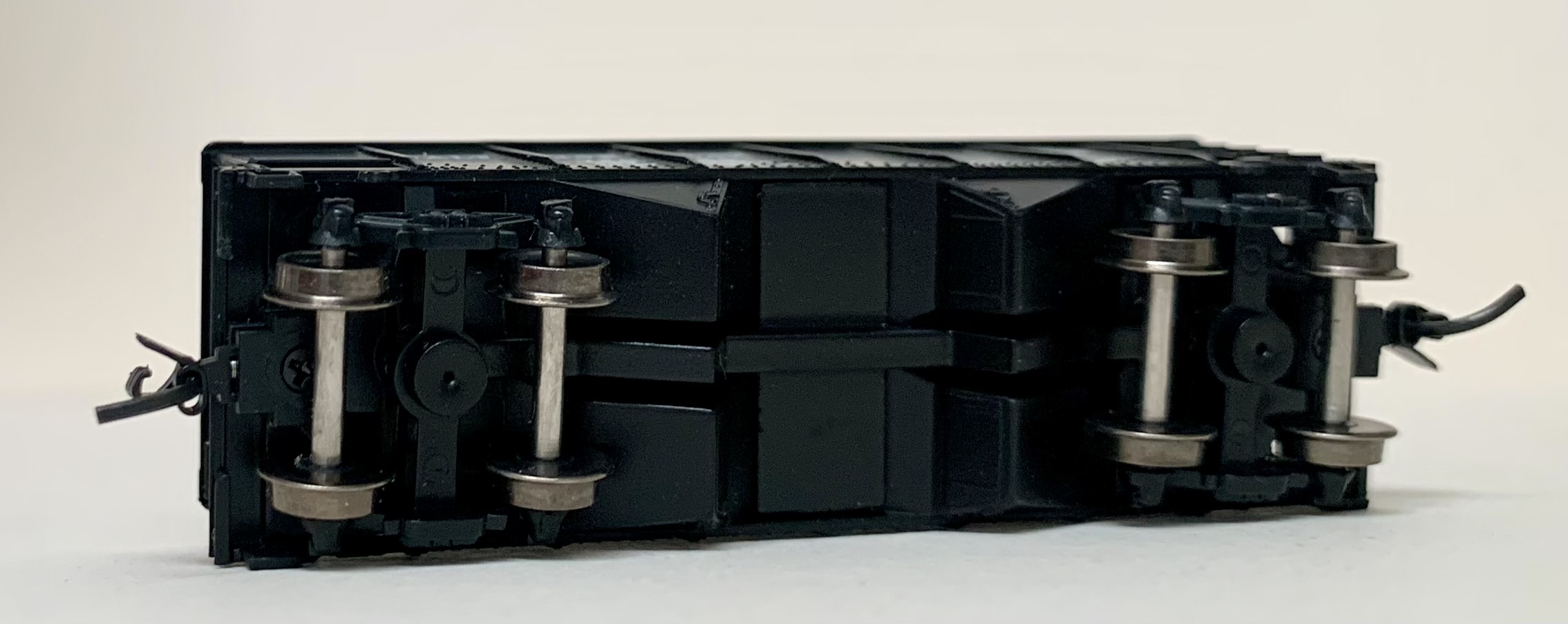
The Bowser Trains model is 2 1/2 inches long and weighs 0.60 ounces both with and without the thin plastic coal load. This is exceptionally light according to the National Model Railroad Association (NMRA) recommendations (0.90 ounces) - but there is ample room to add weight inside the open bay compartments if desired. It was a solid runner, even at its light weight, while testing the car on Kato Unitrack with no issues around curves or through turnouts at slow and medium speeds.
Bowser Trains offers a solid meat-n-potatoes Pennsylvania Railroad GLa coal hopper without a lot of frills. A prototypical correct model with crisp rivet and panel lines, body-mounted couplers with metal wheels, and quality paint & lettering. But a lack of interior/underside detail, unimpressive coal load, and too many molded parts keep it in the middle of the pack.
To see a list of all cars in this series, CLICK HERE

